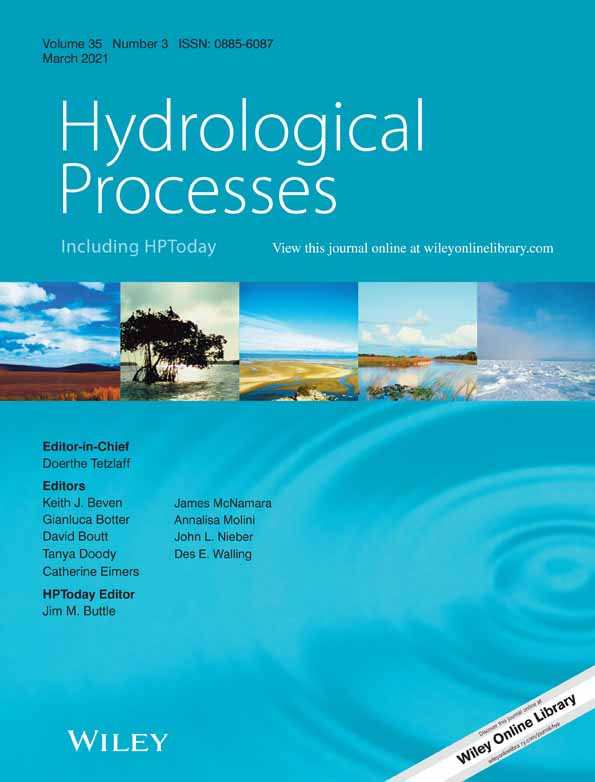BIFoR FACE: Water–soil–vegetation–atmosphere data from a temperate deciduous forest catchment, including under elevated CO2
Abstract
The ecosystem services provided by forests modulate runoff generation processes, nutrient cycling and water and energy exchange between soils, vegetation and atmosphere. Increasing atmospheric CO2 affects many linked aspects of forest and catchment function in ways we do not adequately understand. Global levels of atmospheric CO2 will be around 40% higher in 2050 than current levels, yet estimates of how water and solute fluxes in forested catchments will respond to increased CO2 are highly uncertain. The Free Air CO2 Enrichment (FACE) facility of the University of Birmingham's Institute of Forest Research (BIFoR) is the only FACE in mature deciduous forest. The site specializes in fundamental studies of the response of whole ecosystem patches of mature, deciduous, temperate woodland to elevated CO2 (eCO2). Here, we describe a dataset of hydrological parameters – seven weather parameters at each of three heights and four locations, shallow soil moisture and temperature, stream hydrology and CO2 enrichment – retrieved at high frequency from the BIFoR FACE catchment.
1 DATASET NAME
BIFoR FACE catchment data.
2 SITE DESCRIPTION
2.1 The Wood Brook catchment and FACE facility
The BIFoR FACE facility (52°48′3.6″ N, 2°18′0″ W, 106 m above mean sea level [amsl]) is situated in a mainly agricultural headwater catchment in the UK drained by the Wood Brook, and consists of the main elevated CO2 (eCO2) facility and a number of other study sites including tree planting of different age and management (Figure 1). Wood Brook is a second-order stream with a 3.1 km2 catchment ranging in elevation from 90 to 150 m amsl (Blaen, Brekenfeld, et al., 2017) and subsequently draining into the River Severn catchment (the most voluminous river in England and Wales). The entire catchment is undergoing substantial land-use change, having been converted to organic farming since 2019. Herbal leys (i.e., mixed grass, legumes, and deep-rooting herbs) and tree planting now replace what was previously grass monoculture or arable.
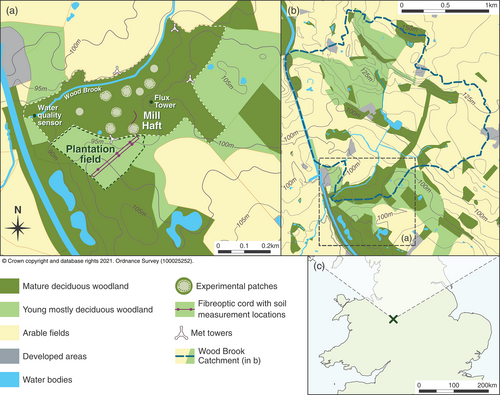
The BIFoR FACE forest (Mill Haft, Figure 1), at the bottom of the Wood Brook catchment, is a deciduous woodland, with dominant (25-m tall) English oak (Quercus robur) planted around 1850 (Hart et al., 2019). Each stem with diameter-at-breast-height greater than 10 cm has been geolocated and tagged. Centimetre-scale forest structure was measured by a lidar overflight in August 2014 and by terrestrial laser scanning (private communication, Eric Casella, Forest Research, Surrey, UK); this structure establishes the basis for penetration of air, light, and water into the forest canopy.
The central, eCO2 component of BIFoR FACE consists of nine experimental patches of 15 m radius (Figure 2; Hart et al., 2019; Norby et al., 2015). Three undisturbed patches have no CO2-dosing infrastructure. Three ‘control’ patches are exposed to ambient CO2 (aCO2) concentrations, delivered via the same infrastructure used in the three ‘treatment’ (eCO2) patches. The eCO2 patches are maintained at +150 ppmv above ambient CO2 at all levels of the canopy during daylight hours from oak bud burst (ca. 1st April) to last leaf fall (ca. 31st October). The first season with eCO2 was 2017 and the treatment will continue until at least 2026. A parallel study of the effect of nitrogen and phosphorus addition began in 2020 in the forest away from the FACE patches.
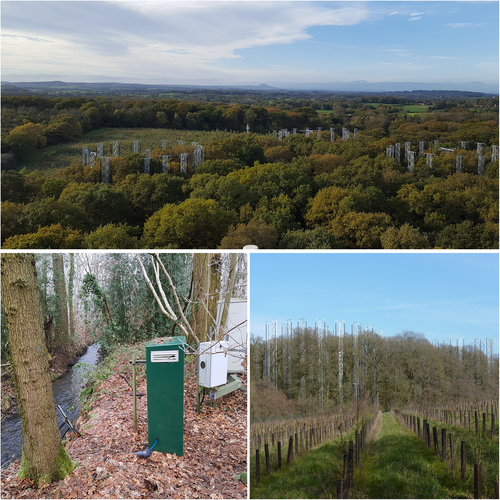
Elsewhere in the Wood Brook catchment, in partnership with the estate owners, young mixed mostly-deciduous plantations are subjected to different manipulation treatments including irrigation and fertilization experiments.
2.2 The environmental context
Wood Brook catchment is in the temperate maritime zone of north-west Europe (Barry & Chorley, 2010). The site-mean annual temperature (MAT) measured between 2016 and 2019 was 10.6 ± 0.8°C and its mean annual precipitation (MAP) was 676 ± 66 mm. The catchment is within the area covered by the Central England Temperature record, which provides a time series back to 1772 (Parker et al., 1992). The Wood Brook catchment is situated in a Nitrate Vulnerable Zone (European Union Directive 91/676/EEC) with mean nitrate concentrations in the Wood Brook ranging from 5 to 7 mg N L−1 (Blaen, Khamis, et al., 2017). The contemporary reactive nitrogen deposition from the atmosphere in the catchment is ~22 kg N ha−1 y−1 (private communication, S. Tomlinson, UK Centre for Ecology & Hydrology). Deposition of this scale represents less than about 15% of the total nitrogen nutrition of temperate deciduous forest trees (Rennenberg & Dannenmann, 2015).
3 METHODS
This summary complements online introductory videos (https://tinyurl.com/y3a2hkkx) and draws on the facility ‘White Book’ (https://www.birmingham.ac.uk/research/bifor/face/index.aspx), which is a live web-document containing extensive details of all the projects undertaken at the facility and details of instrument placement (heights, depths, spatial separation).
The Wood Brook is equipped with two water quality monitoring stations (Figure 2, bottom left) comprising in-stream sensors measuring stage, water temperature, and electrical conductivity up to every 10 s. Sensors to measure further parameters (UV–VIS absorbance, DO, pH, and turbidity) are housed in an insulated kiosk located on the streambank (Blaen, Khamis, et al., 2017). An ISCO peristaltic pump (Lincoln, NE, USA) passes 1 L of stream water through these sensors every hour. Stream monitoring is supplemented with campaign-based sampling facilitated by networks of surface water ISCO autosamplers, for instance during tracer tests (Blaen, Brekenfeld, et al., 2017; Blaen, Khamis, et al., 2017), as well as spatially nested multi-level mini-piezometers installed in the streambed to investigate streambed biogeochemical processes and groundwater–surface water interactions (Comer-Warner et al., 2019; Comer-Warner et al., 2020). A stage-discharge relationship for the Wood Brook was developed by Blaen, Khamis, et al. (2017).
Volumetric soil moisture content in the main BIFoR FACE facility is monitored by 12 cm long frequency domain reflectometry sensors (CS655 by Campbell Scientific [Logan, USA], ±3% v/v for typical soils) installed diagonally from the surface in triangular groups of three spaced 1 m apart, with two groups in the ‘control’ and ‘treatment’ patches and one group in the undisturbed patches, and monitoring at 15 to 30 min resolution.
In addition, one of the juvenile plantations close to the catchment outlet (Figure 2, bottom right) has been instrumented since 2016 with active fibre-optic distributed temperature sensing (FO-DTS connected to a XT-DTS™ unit and a heat pulse system by Silixa Ltd., London, UK). The fibre-optic system can measure soil temperature every 30 s and soil moisture every 6 h at a submeter spatial resolution, resulting in 1850 soil temperature and soil moisture sampling locations across the site, ranging from 10–40 cm depths (Abesser et al., 2020). The current dataset provides 6-hourly retrievals of soil temperature and soil moisture. The retrieval from the FO-DTS has a maximum at 38% v/v, a value empirically determined from a soil-specific field calibration against point soil moisture sensors installed adjacent to the fibre-optic cable. Uncertainties of ca. 3–5% v/v have been reported for soil moisture measurements with the DTS technique (Gamage et al., 2018).
Each treatment and control experimental patch is ringed by 16 free-standing, climbable, lattice towers that reach 2–3 m above the local oak canopy; a 17th tower is sited in the centre of each patch. The lattice towers are secured by helical piles; the experimental site contains no concrete foundations or guy wires. Access to the experimental patches is via low-level walkways raised approximately 30 cm above ground level to prevent compaction. Canopy access above 5 m is contracted to climbing arborists or achieved using a bespoke canopy access system (CAS) installed from the 17th central tower of each infrastructure array. Tissue samples (e.g., leaves, catkins, insects) are collected via the CAS and from ground-based collectors. Although not the subject of the present Data Note, we include a description of tissue curation for completeness and to demonstrate the joined-up nature of the BIFoR FACE data pipeline. All tissue is recorded when sampled and a chain-of-custody initiated using Pro-curo (Pro-curo software Ltd., Horsham, UK). Quenching of biological samples to −70°C is accomplished on-site using a dry shipper (BioTrex-10, Statebourne Cryogenics, Tyne & Wear, UK), avoiding the need for liquid nitrogen in the field. The permanent tissue bank resides at the University of Birmingham Edgbaston campus.
Four meteorological masts are located at the periphery of the woodland and measure a wide range of weather parameters (see Figure 3), with sensors are located at 2 m from the surface and/or at the top of the towers at 25 m. Sensors are HMP 155RH for air temperature and relative humidity and PTB210 for atmospheric pressure by Vaisala (Helsinki, Finland); LI190 for PAR light by LI-COR Biosciences (Lincoln, Nebraska, USA); Lite 2 for net radiation by Kipp & Zonen (Delft, The Netherlands); TR-525M for precipitation by Texas Electronics (Dallas, TX, USA). Wind speed and direction is measured at 25 m on the FACE infrastructure with a WMT701 by Vaisala. Additional weather parameters are measured in the FACE infrastructure including ground rain gauges (ARG100), air temperature thermistors (107) top of the canopy solar radiation (LP02) all by Campbell Scientific (Logan, Utah, USA) which also supplied the data loggers used across the site (CR6 and CR1000X). A 40 m ‘flux tower’ stands towards the downwind end of the wooded area but does not yet provide data to the Dataset.
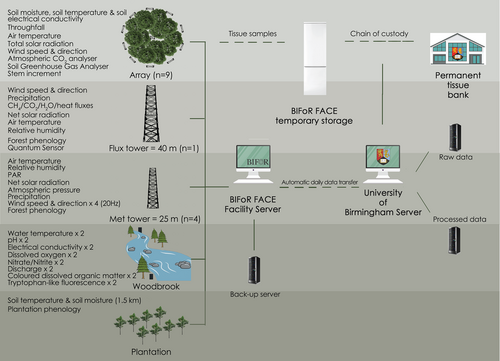
Figure 3 illustrates the flow of data and tissue samples into their permanent repositories. Other equipment (not shown) is deployed ad hoc within specific projects. Data is transferred daily to the University of Birmingham servers and the raw and processed data are stored separately to improve backup redundancy. The data processing step here involves re-formatting for ease-of-use and human-in-loop quality assurance to remove evident issues (e.g., nil raingauge returns when staff observe rain or data far outside the normal range), flagged or corroborated by technical staff as they pass the data to the Data Manager.
To complement the experimental infrastructure in the Wood Brook catchment and BIFoR FACE facility, an integrated groundwater–surface water model has been developed and validated by a combination of flow signatures and applied to investigate stream and subsurface water and energy balance in response to forest shading (Qiu et al., 2019).
4 EXAMPLE RESULTS
4.1 Soil moisture dynamics, stream discharge, and water quality in mature forest and young plantation
Example data demonstrate the value of long-term integrated monitoring in ecohydrological observatories such as the Wood Brook catchment (Figure 4). The variability of the temperate maritime climate is evident: prolonged wetting and drying events are shown clearly in both time series, overlaid by occasional, shorter, high-intensity rainfall events. Signals can take a long time to emerge within such variability, which is a key argument for a long-term experimental platform such as BIFoR FACE. The time series at this relatively early stage suggests that: (i) the plantation is systematically wetter than the neighbouring forest even though the plantation slopes downwards towards Mill Haft; (ii) there is significant spatial variability in the plantation and Mill Haft; and (iii) the eCO2 patches are drier than the aCO2 and undisturbed patches. Point (iii) may be a result of spatial variability in the forest; the strength of soil drying or moistening due to eCO2, if any is present (cf. Drake et al., 2016; Ellsworth, 1999), remains to be quantified.
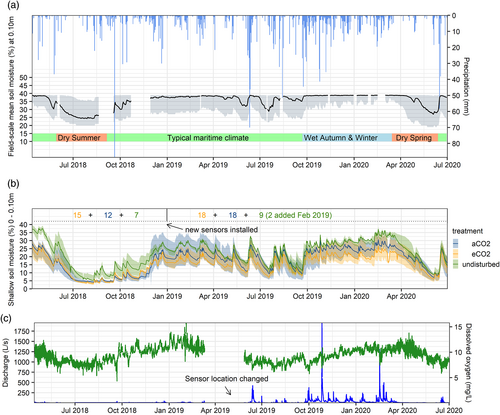
Corresponding discharge at the Wood Brook catchment outlet highlights the general ‘flashiness’ of the flow regime, with relatively fast responses to precipitation events for a permeable catchment as well as fast recession of flow (Figure 4c). The time series also indicates some of the challenges in maintaining consistent quality control throughout long-term observation networks. In addition to data losses induced by power supply failures in April–June 2019, observed values up to early 2019 were an order of magnitude lower than from June 2019 onwards due to repeated sedimentation of the water level sensor and recurring changes to the channel cross sectional profile that finally led to a relocation of the sensor and to a more stable measurement as indicated in Figure 4c. The data offers the ability to observe long-term trends in catchment behaviour in response to land-use changes, mechanistic process understanding of in-stream metabolism and biogeochemical processing, and event-based activation of pollution sources (Blaen, Khamis, et al., 2017).
5 DATA PROTOCOL AND OWNERSHIP
BIFoR FACE is highly collaborative in nature and welcomes partners1 who wish to contribute as part of a multidisciplinary Community of Practice. All projects form part of the overall collaborative effort to understand catchment behaviour and forest form and function, and all facility users sign a data protocol to that effect (see the online White Book described above). The BIFoR FACE science community believe and advocate transparency in science, assured through open data, after an agreed period of use by the data originators typically equal to the duration of the project (i.e., 1–5 years). Data ownership and data originators are included in the dataset metadata. The dataset is supported by a full-time data manager (author GC), responsible for tracking all data and tissue samples (e.g., leaf and insect collections) and is the first point of contact for specific data requests, including the raw data. The data manager and the researchers are responsible for the quality control of the data which usually consists of constraining values within physical limits, removing outliers after inspection and filling gaps with alternative sources (if available) or via interpolation methods.
6 CONTRIBUTORS
In addition to the authors of the present work, technical and scientific assistance and advice has contributed to the BIFoR FACE dataset. The soil moisture FO-DTS system installation was led by Francesco Ciocca while holding joint positions at the University of Birmingham and at Silixa Ltd. (London, UK). The BIFoR FACE facility cannot run without the dedicated support of its operations team (currently; Nicholas Harper, Peter Miles, Thomas Downes, Gael Denny and Robert Grzesik, formerly; Gary McClean and Anna Gardner). Foundational contributions to the design and implementation of the facility were made by Michael Tausz and Sabine Tausz-Posch. The FACE facility eCO2 treatment uses the system designed by John Nagy and installed by Keith Lewin, both of Brookhaven National Lab, USA.
ACKNOWLEDGEMENTS
We are grateful to the editor and referees for their careful and constructive efforts to improve this note. We acknowledge the considerable scientific input of visiting fellows (David Ellsworth, Kristine Crous, Debbie Hemming, Rich Norby, Theresa Blume and Mantha Phanikumar) and former researchers (Will Allwood, Alex Poynter). We gratefully acknowledge strategic guidance from BIFoR Directors (Rob Jackson, Jerry Pritchard, and Nicola Spence) and the Science Committee (Christine Foyer, Vincent Gauci, Francis Pope, and Estrella Luna Diez). BIFoR FACE is supported by the JABBS Trust, Norbury Park Estate, The John Horseman Trust, Ecological Continuity Trust, the Natural Environment Research Council (NERC; grants NE/S015833/1, NE/P003486/1, NE/N020502/1; NE/T000449/1; NE/T012323/1), and the University of Birmingham.
ENDNOTE
Open Research
DATA AVAILABILITY STATEMENT
The BIFoR FACE dataset is publicly accessible at https://doi.org/10.25500/edata.bham.00000564. Datasets are compressed zip files, usually in csv format but with the larger datasets stored in binary fst format. The binary files can be opened with code available in R (R Core Team, 2020) via the fst library (Klik, 2020). All datasets come with a daily resolution except the stream data which is hourly and the DTS data that comes in its original sampling resolution with a 1 m spatial resolution. Associated with the dataset is a readme file containing metadata. An inquiry form is available on the BIFoR website for potential collaborators wishing to use the facility (https://www.birmingham.ac.uk/research/bifor/face/using-face.aspx).



